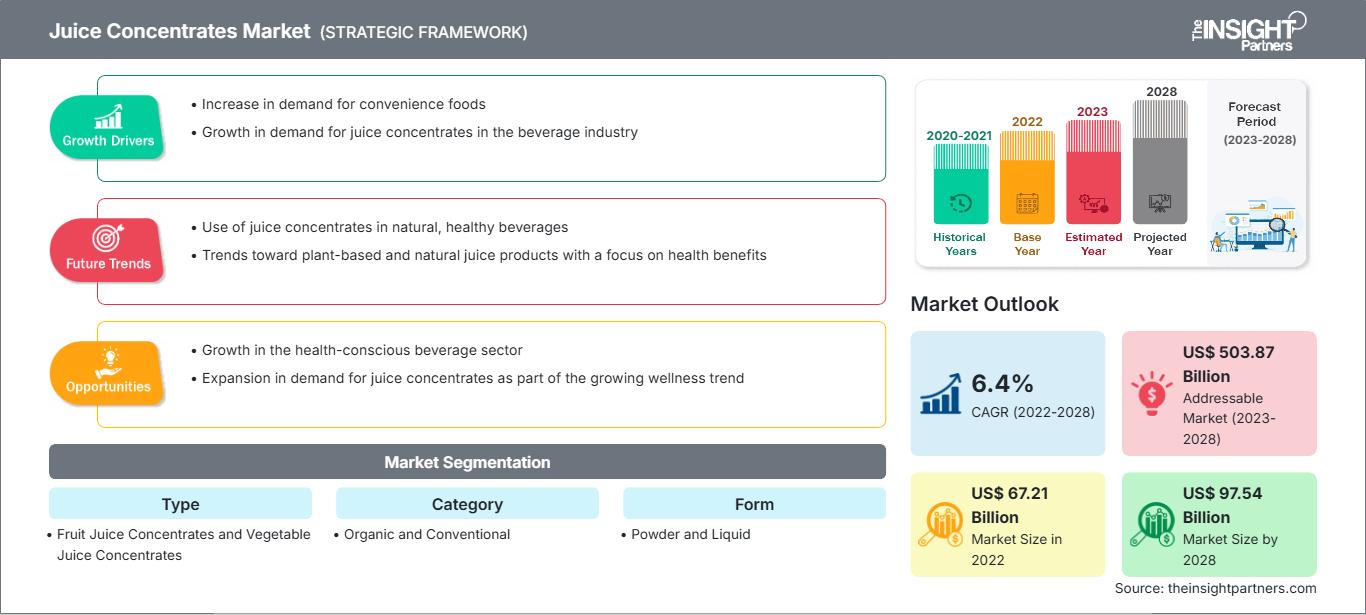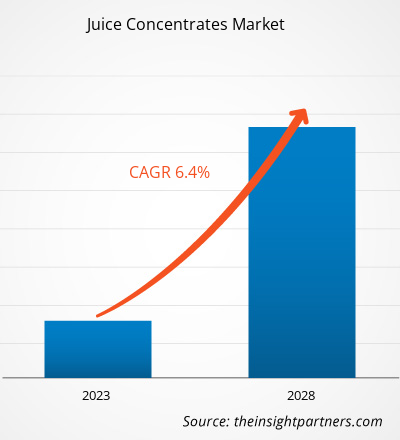Si prevede che il mercato dei succhi concentrati crescerà da 67.210,96 milioni di dollari nel 2022 a 97.541,12 milioni di dollari entro il 2028; si stima che registrerà un CAGR del 6,4% dal 2022 al 2028.
I succhi concentrati vengono prodotti estraendo l'acqua dai succhi di frutta e verdura. A seconda del tipo di frutta e verdura utilizzata durante il processo, questi concentrati offrono nutrienti essenziali come minerali e vitamine. I succhi concentrati sono sottoposti a un processo di lavorazione più complesso rispetto ai succhi grezzi. L'acqua viene estratta nei succhi concentrati poiché contribuisce a ridurre la proliferazione batterica. I succhi concentrati vengono generalmente conservati a temperatura ambiente o congelati e poi diluiti in acqua filtrata prima del consumo. I concentrati di frutta sono ricchi di vitamina C e altri antiossidanti che contribuiscono a promuovere la salute della pelle e a rallentare gli effetti dell'invecchiamento cutaneo. Viene solitamente consumato dai consumatori come alternativa sana al succo appena spremuto.
Nel 2022, l'Europa deteneva la quota maggiore del mercato dei succhi concentrati. Si stima che il mercato nell'area Asia-Pacifico crescerà al CAGR più elevato durante il periodo di previsione. La crescita del mercato in Europa è attribuita alla presenza di operatori affermati come AGRANA Beteiligungs-AG, Archer Daniels Midland Company, Berrifine A/S, Ingredion Incorporated e Dohler GmbH. Con la crescente attenzione alla salute tra i consumatori, si prevede che la domanda di prodotti naturali preparati con succhi concentrati continuerà a crescere nel periodo di previsione. Inoltre, la domanda di bevande a base di frutta da asporto è in aumento a causa degli stili di vita frenetici dei consumatori in tutta la regione. Il crescente consumo di succhi concentrati e di prodotti a base di succhi concentrati, come zuppe, salse e bevande, è dovuto alla crescente adozione di succhi di frutta e verdura rispetto alle bevande gassate, soprattutto da parte dei consumatori attenti alla salute.
Personalizza questo rapporto in base alle tue esigenze
Potrai personalizzare gratuitamente qualsiasi rapporto, comprese parti di questo rapporto, o analisi a livello di paese, pacchetto dati Excel, oltre a usufruire di grandi offerte e sconti per start-up e università
Mercato dei concentrati di succhi: Approfondimenti strategici

- Ottieni le principali tendenze chiave del mercato di questo rapporto.Questo campione GRATUITO includerà l'analisi dei dati, che vanno dalle tendenze di mercato alle stime e alle previsioni.
Potrai personalizzare gratuitamente qualsiasi rapporto, comprese parti di questo rapporto, o analisi a livello di paese, pacchetto dati Excel, oltre a usufruire di grandi offerte e sconti per start-up e università
Mercato dei concentrati di succhi: Approfondimenti strategici

- Ottieni le principali tendenze chiave del mercato di questo rapporto.Questo campione GRATUITO includerà l'analisi dei dati, che vanno dalle tendenze di mercato alle stime e alle previsioni.
Impatto della pandemia di COVID-19 sul mercato dei concentrati di succhi
La pandemia di COVID-19 ha colpito economie e settori in diversi paesi. Lockdown, restrizioni di viaggio e chiusure aziendali in Nord America, Europa, Asia-Pacifico (APAC), America meridionale e centrale e Medio Oriente e Africa (MEA) hanno ostacolato la crescita di diversi settori, tra cui quello alimentare e delle bevande. La chiusura delle unità produttive ha interrotto le catene di approvvigionamento globali, le attività produttive, i programmi di consegna e le vendite di prodotti essenziali e non essenziali. Diverse aziende hanno registrato ritardi nelle consegne dei prodotti e un crollo delle vendite nel 2020. Inoltre, i divieti imposti dai governi di vari paesi in Europa, Asia-Pacifico e Nord America sui viaggi internazionali hanno costretto le aziende a interrompere temporaneamente i loro piani di collaborazione e partnership. Tutti questi fattori hanno ostacolato diversi settori nel 2020 e all'inizio del 2021, frenando così la crescita di diversi mercati, tra cui quello dei succhi concentrati.
Prima dell'inizio della pandemia di COVID-19, la domanda di succhi concentrati era elevata a causa della crescente domanda di prodotti da forno e dell'aumento della produzione di diversi prodotti aromatizzati. Tuttavia, le industrie manifatturiere hanno dovuto affrontare sfide senza precedenti dopo l'emergere della pandemia nel 2020. I produttori di succhi concentrati hanno riscontrato numerosi problemi a causa dei vincoli della catena di approvvigionamento causati dal lockdown nazionale, dai divieti commerciali e dalle restrizioni di viaggio. L'interruzione della catena di approvvigionamento ha causato lo stoccaggio delle materie prime, che ha influito sulla produzione e sulla distribuzione dei succhi concentrati, con conseguente aumento dei prezzi. Inoltre, si è registrato un enorme divario tra domanda e offerta a causa del lockdown e delle restrizioni di viaggio.
Approfondimenti di mercato
Sviluppi strategici dei principali attori per favorire la crescita del mercato dei succhi concentrati durante il periodo di previsione
A maggio 2022, Austria JuiceGmbH, una joint venture tra AGRANA Beteiligungs-AG (AGRANA) e Raiffeisen Ware Austria AG (RWA), ha costruito un impianto fotovoltaico su larga scala presso il suo stabilimento di concentrati di succhi di frutta a Kröllendorf, in Alta Austria. In questo sito, l'azienda produce concentrati di succhi di frutta, puree di frutta e aromi naturali, nonché composti per bevande e succhi non concentrati per il settore delle bevande a valle. Si prevede che tali sviluppi strategici da parte dei principali attori del mercato stimoleranno la crescita del mercato dei succhi concentrati nei prossimi anni.
Approfondimenti basati sulla tipologia
In base alla tipologia, il mercato dei succhi concentrati si divide in concentrati di frutta e concentrati di verdura. Il segmento dei concentrati di frutta ha detenuto una quota di mercato maggiore nel 2022 e si prevede che il segmento dei concentrati di verdura registrerà un CAGR più elevato durante il periodo di previsione. Il concentrato di succo si ottiene dall'estrazione dell'acqua dal succo di frutta e offre alcuni nutrienti essenziali, tra cui vitamine e minerali. La rimozione del contenuto d'acqua tramite evaporazione può trasformare il succo fresco in un concentrato di succo, utilizzato come agente aromatizzante in altri prodotti alimentari e bevande. I concentrati di frutta vengono spesso miscelati con acqua per ricreare bevande a base di succo deliziose e rinfrescanti. I concentrati di succhi di frutta sono utilizzati principalmente per la produzione di succhi di frutta, bibite analcoliche e nettari.
Approfondimenti sulla categoria
In base alla categoria, il mercato dei concentrati di succhi si divide in biologico e convenzionale. Il segmento convenzionale ha detenuto una quota di mercato maggiore nel 2022 e si prevede che il segmento biologico registrerà un CAGR più elevato durante il periodo di previsione. L'agricoltura convenzionale di frutta e verdura consente l'uso di fertilizzanti sintetici, letame, compost, fanghi di depurazione e altri ammendanti del terreno. Frutta e verdura della categoria convenzionale vengono irrorate con diversi fertilizzanti chimici, pesticidi ed erbicidi e seguono metodi artificiali come le tecniche di organismi geneticamente modificati. Di conseguenza, l'agricoltura convenzionale è più economica di quella biologica. Pertanto, i concentrati di succhi convenzionali sono più economici di quelli biologici.
Approfondimenti sulla forma
In base alla forma, il mercato dei concentrati di succhi si divide in polvere e liquido. Il segmento dei liquidi ha detenuto una quota di mercato maggiore nel 2022 e si prevede che il segmento delle polveri registrerà un CAGR più elevato durante il periodo di previsione. I solventi derivanti da frutta e verdura e l'estratto vegetale acquistato sono disponibili in forma liquida. Questo estratto liquido può essere ulteriormente lavorato in polvere o distribuito nelle industrie di consumo finale per varie applicazioni. La forma liquida è la forma di succo concentrato maggiormente disponibile in quanto richiede una lavorazione minima rispetto ad altre forme.
Approfondimenti sulle applicazioni
In base all'applicazione, il mercato dei succhi concentrati è segmentato in prodotti da forno e dolciumi; bevande; zuppe, salse e condimenti; latticini e dessert surgelati; e altri. Il segmento delle bevande ha detenuto la quota di mercato maggiore nel 2022 e si prevede che il segmento dei prodotti da forno e dolciumi registrerà il CAGR più elevato durante il periodo di previsione. I succhi concentrati sono ampiamente utilizzati nella produzione di bevande biologiche e convenzionali, come acqua, spruzzi di frutta, bibite gassate, bevande al tè, miscele per birra, sidro e liquori, il che sta stimolando la crescita del segmento delle bevande. Questa crescita è supportata anche dalla crescente domanda di bevande salutari, funzionali e che rafforzano il sistema immunitario. Alcuni importanti produttori di bevande, come Döhler, offrono diversi prodotti, tra cui concentrati stabili alla CO2, concentrati di succhi chiarificati e concentrati di succhi stabili all'alcol.
Ciatti Co, Berrifine AS, Archer-Daniels-Midland Co, AGRANA Beteiligungs AG, Dohler GmbH, Kanegrade Ltd, CitroGlobe SRL, SVZ International BV e IPRONA SpA sono tra i principali attori che operano nel mercato dei succhi concentrati. Queste aziende si concentrano principalmente sull'innovazione di prodotto per espandere le proprie dimensioni di mercato e seguire le tendenze emergenti.
Approfondimenti regionali sul mercato dei concentrati di succhi
Le tendenze regionali e i fattori che influenzano il mercato dei concentrati di succhi durante il periodo di previsione sono stati ampiamente spiegati dagli analisti di The Insight Partners. Questa sezione illustra anche i segmenti e la geografia del mercato dei concentrati di succhi in Nord America, Europa, Asia-Pacifico, Medio Oriente e Africa, America meridionale e centrale.
Ambito del rapporto di mercato sui concentrati di succhi
| Attributo del rapporto | Dettagli |
|---|---|
| Dimensioni del mercato in 2022 | US$ 67.21 Billion |
| Dimensioni del mercato per 2028 | US$ 97.54 Billion |
| CAGR globale (2022 - 2028) | 6.4% |
| Dati storici | 2020-2021 |
| Periodo di previsione | 2023-2028 |
| Segmenti coperti |
By Tipo
|
| Regioni e paesi coperti | Nord America
|
| Leader di mercato e profili aziendali chiave |
|
Densità degli operatori del mercato dei concentrati di succhi: comprendere il suo impatto sulle dinamiche aziendali
Il mercato dei succhi concentrati è in rapida crescita, trainato dalla crescente domanda da parte degli utenti finali, dovuta a fattori quali l'evoluzione delle preferenze dei consumatori, i progressi tecnologici e una maggiore consapevolezza dei benefici del prodotto. Con l'aumento della domanda, le aziende stanno ampliando la propria offerta, innovando per soddisfare le esigenze dei consumatori e sfruttando le tendenze emergenti, alimentando ulteriormente la crescita del mercato.

- Ottieni il Mercato dei concentrati di succhi Panoramica dei principali attori chiave
In evidenza nel rapporto
- Tendenze progressive del settore nel mercato dei concentrati di succo per aiutare le aziende a sviluppare strategie efficaci a lungo termine
- Strategie di crescita aziendale adottate dagli operatori del mercato nei paesi sviluppati e in via di sviluppo
- Analisi quantitativa del mercato dal 2022 al 2028
- Stima della domanda globale di concentrati di succo
- Analisi delle cinque forze di Porter per illustrare l'efficacia di acquirenti e fornitori nel mercato dei concentrati di succo
- Sviluppi recenti per comprendere lo scenario competitivo del mercato
- Tendenze e prospettive di mercato, fattori trainanti e vincoli della crescita nel mercato dei concentrati di succo
- Assistenza nel processo decisionale evidenziando le strategie di mercato che sostengono l'interesse commerciale
- Dimensioni del mercato dei concentrati di succo in vari nodi
- Panoramica dettagliata e segmentazione del mercato e dinamiche di crescita dei concentrati di succo industria
- Dimensioni del mercato dei concentrati di succhi in varie regioni con promettenti opportunità di crescita
- Analisi storica (2 anni), anno base, previsione (7 anni) con CAGR
- Analisi PEST e SWOT
- Valore/volume delle dimensioni del mercato - Globale, Regionale, Nazionale
- Industria e panorama competitivo
- Set di dati Excel
Report recenti
Testimonianze
Motivo dell'acquisto
- Processo decisionale informato
- Comprensione delle dinamiche di mercato
- Analisi competitiva
- Analisi dei clienti
- Previsioni di mercato
- Mitigazione del rischio
- Pianificazione strategica
- Giustificazione degli investimenti
- Identificazione dei mercati emergenti
- Miglioramento delle strategie di marketing
- Aumento dell'efficienza operativa
- Allineamento alle tendenze normative




















 Ottieni un campione gratuito per - Mercato dei concentrati di succhi
Ottieni un campione gratuito per - Mercato dei concentrati di succhi